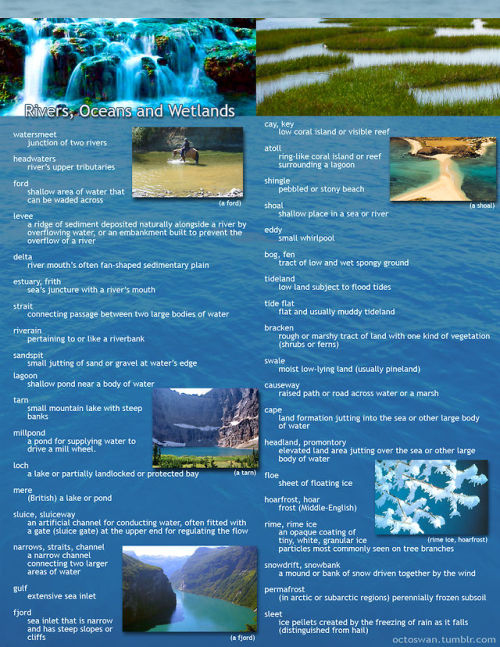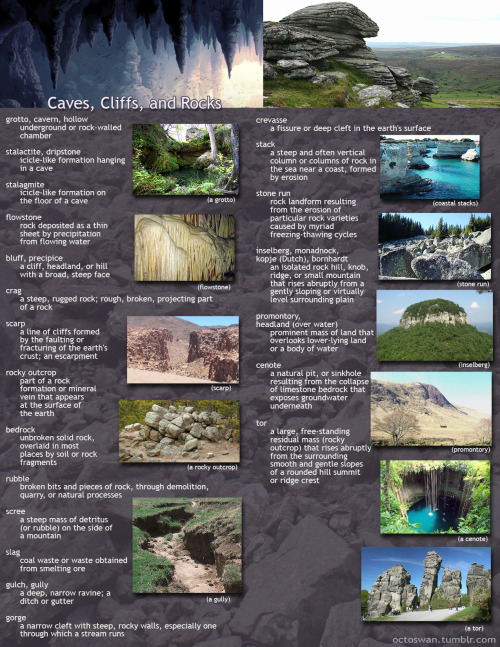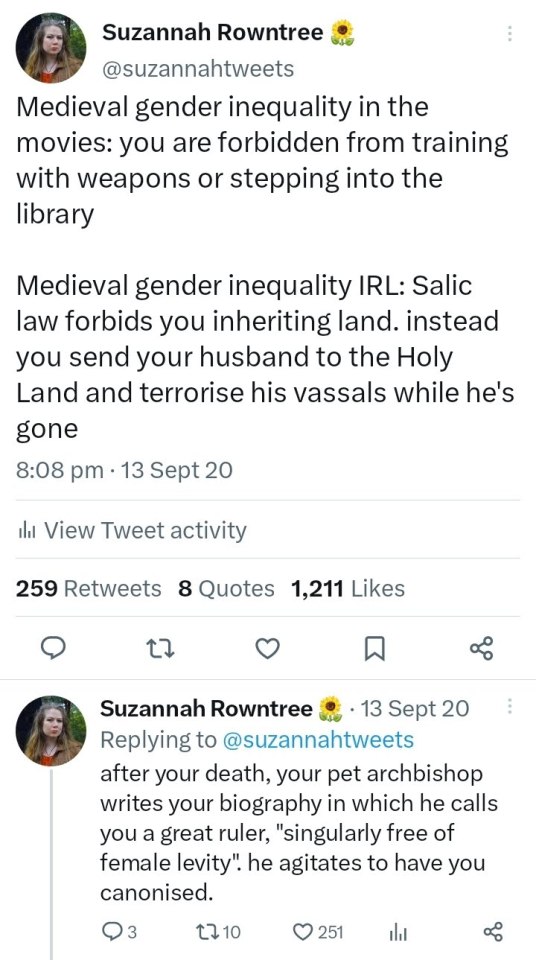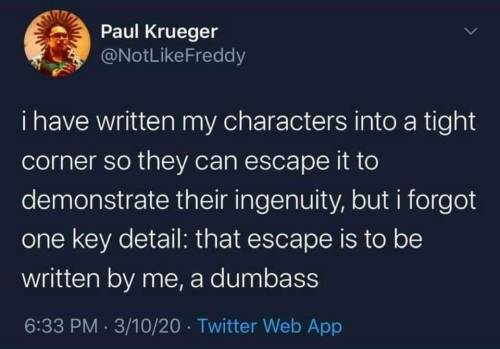Ajkiranwrites - SphinxofBlackQuartz
More Posts from Ajkiranwrites and Others





I made these as a way to compile all the geographical vocabulary that I thought was useful and interesting for writers. Some descriptors share categories, and some are simplified, but for the most part everything is in its proper place. Not all the words are as useable as others, and some might take tricky wording to pull off, but I hope these prove useful to all you writers out there!
(save the images to zoom in on the pics)
🔴can you help me 🇵🇸🍉
This is my home Which was destroyed by the accursed occupation yesterday I'm not sad about the stones I'm sad about the memories I hope this damned war ends 💔💔😔 🍉🇵🇸
vetted by @90-ghost

reblog only if you’ve received less than 1000 boops! we can all get each other to “max”

Creative Differences
Finery drips in the gallery with walls the color of fake teeth Under glimmering lights and clacking red-sole heels I shake hands, theirs soft, smooth, unstained, mine with indentations the curve of my paintbrush.
They whisper over hors d'oeuvres and caviar about The color matching their second-floor carpet. I hope it pays my rent.
A child smaller than the canvas wanders Away to a painting, unsticks his fist from his mouth, his eyes wide enough to encompass stars. He stays longer than most until his mother drags him away, apologizing as she rejoins her group.
He understands art a lot more than money right now.
I hope every writer who sees this writes LOADS the next few months. Like freetime opens up, no writers block, the ability to focus, etc etc you're able to write loads & make lots of progress <3



🍉 Queer Palestinian Books 🍉
🇵🇸 The algorithm is going to keep silencing my posts, but they're not going to silence me. I grew up with little to no books that made me feel seen as a queer/bisexual Palestinian Arab American. Today, it's still not easy enough to find those books online, even though we have thousands of lists, posts, and directories to guide us. To make your search a little easier, here are a few queer Palestinian books to add to your TBR. Please help me spread this by reblogging. Consider adding these to your least for Read Palestine Week (click for resources)! 💜
🍉 The Skin and Its Girl by Sarah Cypher 🇵🇸 A Map of Home by Randa Jarrar 🍉 Hazardous Spirits by Anbara Salam 🇵🇸 To All the Yellow Flowers by Raya Tuffaha 🍉 You Exist Too Much by Zaina Arafat 🇵🇸 The Specimen's Apology by George Abraham 🍉 Birthright by George Abraham 🇵🇸 Nayra and the Djinn by Iasmin Omar Ata 🍉 Where Black Stars Rise by Nadia Shammas and Marie Enger 🇵🇸 The Twenty-Ninth Year by Hala Alyan 🍉 Guapa by Saleem Haddad 🇵🇸 From Whole Cloth: An Asexual Romance by Sonia Sulaiman
🍉 The Philistine by Leila Marshy 🇵🇸 Love Is an Ex-Country by Randa Jarrar 🍉 Shell Houses by Rasha Abdulhadi 🇵🇸 Queer Palestine and the Empire of Critique by Sa'ed Atshan 🍉 Belladonna by Anbara Salam 🇵🇸 Confetti Realms by Nadia Shammas, Karnessa, Hackto Oshiro 🍉 Blood Orange by Yaffa As 🇵🇸 The ordeal of being known by Malia Rose 🍉 Decolonial Queering in Palestine by Walaa Alqaisiya 🇵🇸 Are You This? Or Are You This?: A Story of Identity and Worth by Madian Al Jazerah, Ellen Georgiou 🍉 This Arab Is Queer: An Anthology by LGBTQ+ Arab Writers 🇵🇸 My Mama's Magic by Amina Awad
"Stop saying 15 year olds with weird interests are cringe, they're 15" this is true however you should also stop saying adults with weird interests are cringe because who gives a shit
"we need less sanitized queer stories" yall keep saying fucking she-ra romanticizes abuse. you couldnt possibly handle less sanitized queer stories

all RIGHT:
Why You're Writing Medieval (and Medieval-Coded) Women Wrong: A RANT
(Or, For the Love of God, People, Stop Pretending Victorian Style Gender Roles Applied to All of History)
This is a problem I see alllll over the place - I'll be reading a medieval-coded book and the women will be told they aren't allowed to fight or learn or work, that they are only supposed to get married, keep house and have babies, &c &c.
If I point this out ppl will be like "yes but there was misogyny back then! women were treated terribly!" and OK. Stop right there.
By & large, what we as a culture think of as misogyny & patriarchy is the expression prevalent in Victorian times - not medieval. (And NO, this is not me blaming Victorians for their theme park version of "medieval history". This is me blaming 21st century people for being ignorant & refusing to do their homework).
Yes, there was misogyny in medieval times, but 1) in many ways it was actually markedly less severe than Victorian misogyny, tyvm - and 2) it was of a quite different type. (Disclaimer: I am speaking specifically of Frankish, Western European medieval women rather than those in other parts of the world. This applies to a lesser extent in Byzantium and I am still learning about women in the medieval Islamic world.)
So, here are the 2 vital things to remember about women when writing medieval or medieval-coded societies
FIRST. Where in Victorian times the primary axes of prejudice were gender and race - so that a male labourer had more rights than a female of the higher classes, and a middle class white man would be treated with more respect than an African or Indian dignitary - In medieval times, the primary axis of prejudice was, overwhelmingly, class. Thus, Frankish crusader knights arguably felt more solidarity with their Muslim opponents of knightly status, than they did their own peasants. Faith and age were also medieval axes of prejudice - children and young people were exploited ruthlessly, sent into war or marriage at 15 (boys) or 12 (girls). Gender was less important.
What this meant was that a medieval woman could expect - indeed demand - to be treated more or less the same way the men of her class were. Where no ancient legal obstacle existed, such as Salic law, a king's daughter could and did expect to rule, even after marriage.
Women of the knightly class could & did arm & fight - something that required a MASSIVE outlay of money, which was obviously at their discretion & disposal. See: Sichelgaita, Isabel de Conches, the unnamed women fighting in armour as knights during the Third Crusade, as recorded by Muslim chroniclers.
Tolkien's Eowyn is a great example of this medieval attitude to class trumping race: complaining that she's being told not to fight, she stresses her class: "I am of the house of Eorl & not a serving woman". She claims her rights, not as a woman, but as a member of the warrior class and the ruling family. Similarly in Renaissance Venice a doge protested the practice which saw 80% of noble women locked into convents for life: if these had been men they would have been "born to command & govern the world". Their class ought to have exempted them from discrimination on the basis of sex.
So, tip #1 for writing medieval women: remember that their class always outweighed their gender. They might be subordinate to the men within their own class, but not to those below.
SECOND. Whereas Victorians saw women's highest calling as marriage & children - the "angel in the house" ennobling & improving their men on a spiritual but rarely practical level - Medievals by contrast prized virginity/celibacy above marriage, seeing it as a way for women to transcend their sex. Often as nuns, saints, mystics; sometimes as warriors, queens, & ladies; always as businesswomen & merchants, women could & did forge their own paths in life
When Elizabeth I claimed to have "the heart & stomach of a king" & adopted the persona of the virgin queen, this was the norm she appealed to. Women could do things; they just had to prove they were Not Like Other Girls. By Elizabeth's time things were already changing: it was the Reformation that switched the ideal to marriage, & the Enlightenment that divorced femininity from reason, aggression & public life.
For more on this topic, read Katherine Hager's article "Endowed With Manly Courage: Medieval Perceptions of Women in Combat" on women who transcended gender to occupy a liminal space as warrior/virgin/saint.
So, tip #2: remember that for medieval women, wife and mother wasn't the ideal, virgin saint was the ideal. By proving yourself "not like other girls" you could gain significant autonomy & freedom.
Finally a bonus tip: if writing about medieval women, be sure to read writing on women's issues from the time so as to understand the terms in which these women spoke about & defended their ambitions. Start with Christine de Pisan.
I learned all this doing the reading for WATCHERS OF OUTREMER, my series of historical fantasy novels set in the medieval crusader states, which were dominated by strong medieval women! Book 5, THE HOUSE OF MOURNING (forthcoming 2023) will focus, to a greater extent than any other novel I've ever yet read or written, on the experience of women during the crusades - as warriors, captives, and political leaders. I can't wait to share it with you all!
-
 soefly liked this · 2 weeks ago
soefly liked this · 2 weeks ago -
 raykayrei liked this · 2 months ago
raykayrei liked this · 2 months ago -
 notamethyst26 liked this · 2 months ago
notamethyst26 liked this · 2 months ago -
 jakarraeloc reblogged this · 3 months ago
jakarraeloc reblogged this · 3 months ago -
 toribookworm22 reblogged this · 3 months ago
toribookworm22 reblogged this · 3 months ago -
 ponyboycs01 liked this · 4 months ago
ponyboycs01 liked this · 4 months ago -
 chekhovs-gun-but-worse liked this · 4 months ago
chekhovs-gun-but-worse liked this · 4 months ago -
 theauthorinblue reblogged this · 4 months ago
theauthorinblue reblogged this · 4 months ago -
 hedgewitchnecromancer liked this · 4 months ago
hedgewitchnecromancer liked this · 4 months ago -
 rivierdelune liked this · 5 months ago
rivierdelune liked this · 5 months ago -
 hope-hopefully-writes reblogged this · 5 months ago
hope-hopefully-writes reblogged this · 5 months ago -
 allyennah reblogged this · 5 months ago
allyennah reblogged this · 5 months ago -
 chosenimagines liked this · 5 months ago
chosenimagines liked this · 5 months ago -
 randomriverreader liked this · 5 months ago
randomriverreader liked this · 5 months ago -
 alovesongtheywrote liked this · 5 months ago
alovesongtheywrote liked this · 5 months ago -
 souristhenewsweet liked this · 5 months ago
souristhenewsweet liked this · 5 months ago -
 humble-introvert0808 liked this · 5 months ago
humble-introvert0808 liked this · 5 months ago -
 puckbees liked this · 5 months ago
puckbees liked this · 5 months ago -
 fox-buried-in-maple-leaves reblogged this · 5 months ago
fox-buried-in-maple-leaves reblogged this · 5 months ago -
 thetreeswillbewatching liked this · 5 months ago
thetreeswillbewatching liked this · 5 months ago -
 classicsandfantasy liked this · 5 months ago
classicsandfantasy liked this · 5 months ago -
 bunnywolfwritesabook reblogged this · 5 months ago
bunnywolfwritesabook reblogged this · 5 months ago -
 bunnywolfwritesabook liked this · 5 months ago
bunnywolfwritesabook liked this · 5 months ago -
 aurorauroboros reblogged this · 5 months ago
aurorauroboros reblogged this · 5 months ago -
 sapientsucculent reblogged this · 5 months ago
sapientsucculent reblogged this · 5 months ago -
 sapientsucculent liked this · 5 months ago
sapientsucculent liked this · 5 months ago -
 redmegarex reblogged this · 6 months ago
redmegarex reblogged this · 6 months ago -
 redmegarex liked this · 6 months ago
redmegarex liked this · 6 months ago -
 internetgiraffekid1673 reblogged this · 6 months ago
internetgiraffekid1673 reblogged this · 6 months ago -
 dripwick reblogged this · 6 months ago
dripwick reblogged this · 6 months ago -
 dripwick liked this · 6 months ago
dripwick liked this · 6 months ago -
 xiaomao-ai-wo reblogged this · 6 months ago
xiaomao-ai-wo reblogged this · 6 months ago -
 xiaomao-ai-wo liked this · 6 months ago
xiaomao-ai-wo liked this · 6 months ago -
 ace-of-hats reblogged this · 6 months ago
ace-of-hats reblogged this · 6 months ago -
 ace-of-hats liked this · 6 months ago
ace-of-hats liked this · 6 months ago -
 stitched-rabbit00 liked this · 6 months ago
stitched-rabbit00 liked this · 6 months ago -
 stardust8653 liked this · 6 months ago
stardust8653 liked this · 6 months ago -
 floralpikmin99 liked this · 6 months ago
floralpikmin99 liked this · 6 months ago -
 tombombadilsboots liked this · 6 months ago
tombombadilsboots liked this · 6 months ago -
 keepcalm-n-writeon reblogged this · 6 months ago
keepcalm-n-writeon reblogged this · 6 months ago -
 outofpuddle reblogged this · 6 months ago
outofpuddle reblogged this · 6 months ago -
 starfleet-warrior liked this · 6 months ago
starfleet-warrior liked this · 6 months ago -
 lady-redshield-writes reblogged this · 6 months ago
lady-redshield-writes reblogged this · 6 months ago -
 mildlybizarrecorvid liked this · 6 months ago
mildlybizarrecorvid liked this · 6 months ago -
 lilac-lazuli liked this · 6 months ago
lilac-lazuli liked this · 6 months ago -
 ash-elair-writes reblogged this · 6 months ago
ash-elair-writes reblogged this · 6 months ago -
 la-beans-guardian liked this · 6 months ago
la-beans-guardian liked this · 6 months ago

Original Work Primary Blog. Sideblog for fanfics @stickdoodlefriend Come yell at me! | 18+
241 posts
